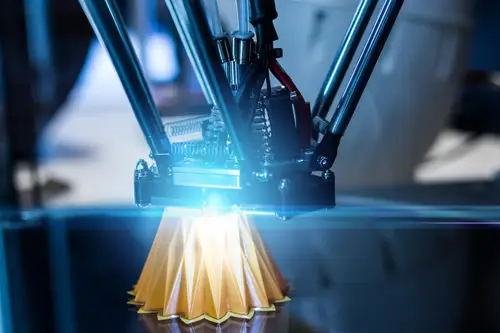Welcome to the fascinating world of 3D printing. An innovative technology that is radically transforming how we conceive manufacturing and design processes. This revolutionary method, also known as Additive Manufacturing, has bulldozed traditional limitations by offering unparalleled flexibility in creating complex structures with precision and efficiency. But just how influential is this groundbreaking invention? And what does it mean for our future? In the post titled “3D Printing Process: Revolutionizing Manufacturing and Design”, you’ll be immersed in a deep dive into the realm of 3D printing. Thereby, exploring its impact on various industries ranging from automotive to healthcare, understanding its potential benefits, challenges associated with it, and envisioning what possibilities lie ahead. Whether you’re tech-savvy or new to this concept altogether; if your curiosity about modern technological advances piques your interest this insightful read will undeniably captivate you! So gear up for a thrilling journey through innovation at its best.
Understanding the Basics of 3D Printing
3D printing, also known as additive manufacturing, is a revolutionary technology that has transformed the way we approach manufacturing and design processes. This innovative technology allows for the creation of three-dimensional objects by depositing material layer by layer. The process begins with a digital design file that is sliced into thin layers, which are then printed sequentially to build the final object. Various materials such as plastics, metals, and ceramics can be used in 3D printing, making it a versatile and flexible manufacturing method. With its ability to produce intricate designs with high precision and efficiency, 3D printing has opened up new possibilities in industries ranging from healthcare to aerospace.
The Evolution and Growth of 3D Printing in Manufacturing
3D printing has undergone significant evolution and growth in the manufacturing industry in recent years. Originally used for prototyping and small-scale production. This technology has advanced to the point where it is now capable of producing complex, high-quality parts at a large scale. This transformation has been driven by improvements in printer speed and accuracy, as well as the development of new materials that are suitable for a wide range of applications. As a result, it is revolutionizing manufacturing processes by offering greater design flexibility, reduced lead times, and cost savings. Its continued expansion into various industries demonstrates the potential for further growth and innovation in the future.
Impact on Design Processes: Transforming Ideation to Reality
The introduction of 3D printing technology has revolutionized the way design processes are conducted, particularly in the fields of manufacturing and product development. One of the key advantages of the technology is its ability to transform ideation into reality with unparalleled speed and precision. Designers and engineers can now create intricate prototypes and products with complex geometries that were previously unattainable using traditional manufacturing methods. This capability allows for rapid iteration and customization, enabling designers to quickly test and refine their ideas before moving into full-scale production.
Furthermore, it has democratized the design process by lowering the barriers to entry for both individuals and small businesses. With the availability of affordable desktop 3D printers, designers no longer need access to expensive manufacturing facilities to bring their concepts to life. This accessibility has led to a surge in creativity and innovation, as designers are free to experiment and push the boundaries of what is possible. Additionally, 3D printing has facilitated a shift towards more sustainable design practices by reducing material waste and energy consumption. Traditional subtractive manufacturing processes often result in significant material wastage, whereas it only uses the material required to build the object, minimizing waste and environmental impact. In conclusion, 3D printing has fundamentally transformed the design process, empowering designers to bring their ideas to life faster, more affordably, and with greater creative freedom than ever before.
Real-world Applications and Case Studies of 3D Printed Products
The impact of 3D printing technology in various industries is evident through its real-world applications and successful case studies. In the medical field, it has revolutionized the production of customized prosthetics, implants, and surgical instruments. For example, surgeons can now create patient-specific implants that perfectly fit a person’s unique anatomy, leading to better outcomes and reduced recovery times. In the aerospace industry, companies like Boeing have utilized 3D printing to produce lightweight components for aircraft, reducing fuel consumption and improving overall performance. In the automotive sector, companies such as Ford have integrated 3D printing into their manufacturing processes to create prototypes and custom parts with increased efficiency and cost-effectiveness. This has enabled faster innovation and product development cycles.
Additionally, the fashion industry has embraced 3D printing for creating intricate designs and personalized accessories. High-end fashion brands like Chanel have incorporated 3D printed elements into their collections, showcasing the technology’s potential in creating unique and complex designs. Moreover, the architecture and construction sectors have benefited from 3D printing technology by enabling the rapid prototyping of building models and intricate structures with precision. Companies like Skanska have utilized this advanced printing technology to create detailed architectural models that aid in the visualization of project plans and designs. Overall, the widespread adoption of 3D printing across various industries showcases its versatility and potential to revolutionize traditional manufacturing and design processes.
Future Prospects: Sustainable Manufacturing with 3D Printing
Prospects for the manufacturing industry lie in sustainable practices, with 3D printing paving the way for innovative solutions. This technology has the potential to reduce material waste and energy consumption, making it a key player in the shift towards more eco-friendly manufacturing processes. By enabling on-demand production and customization, this advanced technology can streamline supply chains and minimize the environmental impact of traditional manufacturing methods. With advancements in materials and techniques, this technology holds promise for creating products that are not only efficient and cost-effective but also environmentally sustainable. Embracing 3D printing as a tool for sustainable manufacturing will undoubtedly shape the future of the industry, offering new possibilities for creating products that align with both economic and environmental goals.

 Exploring the Latest Social Media Trends and How to Use Them
Exploring the Latest Social Media Trends and How to Use Them 10 Hidden iPhone Features You Didn’t Know Existed
10 Hidden iPhone Features You Didn’t Know Existed